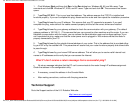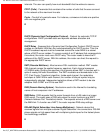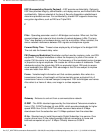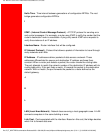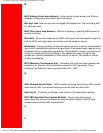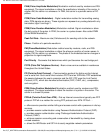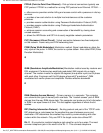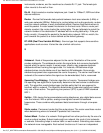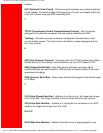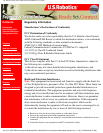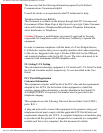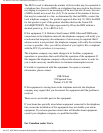
U.S. Robotics SureConnect ADSL Ethernet/USB Router User Guide
PAM (Pulse Amplitude Modulation) Modulation method used by modems and DSL
equipment. The signal modulates or alters the amplitude or intensity of the carrier. In
regular AM, the carrier is a sinewave. In PAM, the carrier is a periodic series of DC
pulses.
PCM (Pulse Code Modulation) - Digital modulation method for transmitting analog
data. PCM signals are binary. These signals can represent any analog data with only
two states, logic 0 and logic 1.
PDM (Pulse Duration Modulation) Modulation method. Signal modulates or alters
the duty cycle of the pulse. In PDM, the carrier is a pulse stream. Also called PWM
(Pulse Width Modulation).
Peak Cell Rate - Maximum rate (Cells/second) for sending cells to the network.
Phase - Position of a periodic waveform.
PM (Phase Modulation) Modulation method used by modems, radio, and DSL
equipment. The signal modulates or alters the phase or position of carrier waves. In
regular PM, the carrier is a sinewave. The phase of the modulated carrier changes in
proportion to signal amplitude.
Port Priority - Parameter that determines which port becomes the root bridge port.
POTS (Plain Old Telephone Service) - Basic voice service available in residences
throughout the United States.
PP (Point-to-Point Protocol) – Communication protocol for dialing up the Internet
over a serial link. Such serial links include a POTS and an ISDN line. PPP establishes
the session between the user’s computer and the ISP. PPP uses the Link Control
Protocol (LCP), which also handles authentication (PAP, CHAP, etc.), compression,
and encryption.
PPM (Pulse Position Modulation) Modulation method used by modems and DSL
equipment. The signal modulates or alters the location of a pulse in the carrier. The
carrier is a stream of pulses.
PPPoA (Point-to-Point Over ATM) – Dial-up Internet connections typically use PPP
protocol. PPPoA is a method for running PPP protocol over ATM. PPPoA… ·
• offers service providers similar billing and access control with a presence in dial-up
services.
• provides session authentication using Password Authentication Protocol (PAP).
• provides session authentication using Challenge Handshake Authentication
Protocol (CHAP).
• achieves session accounting and conservation of bandwidth by closing down
unused sessions.
• allows the IAD/Router and ISP link to easily negotiate network parameters.
file:///P|/T_WRITER/Documentation/Released/900...003%20(Guiness)%20prac%20template/glossary.htm (7 of 11) [11/6/2002 9:02:38 AM]



